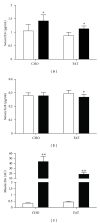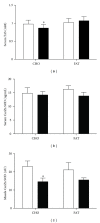Inflammatory and oxidative stress responses to high-carbohydrate and high-fat meals in healthy humans
- PMID: 22474579
- PMCID: PMC3306970
- DOI: 10.1155/2012/238056
Inflammatory and oxidative stress responses to high-carbohydrate and high-fat meals in healthy humans
Abstract
The postprandial state is hypothesised to be proinflammatory and prooxidative, but the relative contributions of fat versus carbohydrate are unclear. Therefore, we examined inflammation and oxidative stress responses in serum and skeletal muscle before and after 1000 kcal meals, which were high in either fat or carbohydrate in 15 healthy individuals. Serum and muscle expression of IL6 was elevated 3 hours after each meal, independently of macronutrient composition (P < 0.01). Serum IL18 was decreased after high-fat meal only (P < 0.01). Plasma total antioxidative status and muscle Cu/Zn-superoxide dismutase were decreased after high-carbohydrate meal only (P < 0.05). We conclude that a high-carbohydrate meal may evoke a greater postprandial oxidative stress response, whereas both fat and carbohydrate increased IL6. We speculate that the observed increases in postprandial IL6, without increases in any other markers of inflammation, may indicate a normal IL6 response to enhance glucose uptake, similar to its role postexercise.
Figures



Similar articles
-
Postprandial adiponectin and gelatinase response to a high-fat versus an isoenergetic low-fat meal in lean, healthy men.Nutrition. 2015 Jun;31(6):863-70. doi: 10.1016/j.nut.2015.01.009. Epub 2015 Feb 26. Nutrition. 2015. PMID: 25933495 Clinical Trial.
-
The relationship between the leptin/ghrelin ratio and meals with various macronutrient contents in men with different nutritional status: a randomized crossover study.Nutr J. 2018 Dec 28;17(1):118. doi: 10.1186/s12937-018-0427-x. Nutr J. 2018. PMID: 30593267 Free PMC article. Clinical Trial.
-
Variations in postprandial ghrelin status following ingestion of high-carbohydrate, high-fat, and high-protein meals in males.Ann Nutr Metab. 2006;50(3):260-9. doi: 10.1159/000091684. Epub 2006 Feb 23. Ann Nutr Metab. 2006. PMID: 16508254 Clinical Trial.
-
Acute Peanut Consumption Alters Postprandial Lipids and Vascular Responses in Healthy Overweight or Obese Men.J Nutr. 2017 May;147(5):835-840. doi: 10.3945/jn.116.246785. Epub 2017 Mar 29. J Nutr. 2017. PMID: 28356431 Free PMC article. Clinical Trial.
-
The effect of culinary doses of spices in a high-saturated fat, high-carbohydrate meal on postprandial lipemia and endothelial function: a randomized, controlled, crossover pilot trial.Food Funct. 2020 Apr 1;11(4):3191-3200. doi: 10.1039/c9fo02438g. Epub 2020 Mar 25. Food Funct. 2020. PMID: 32211679 Clinical Trial.
Cited by
-
An improved model of type 2 diabetes with effects on glucose tolerance, neuropathy and retinopathy with and without obesity.Physiol Behav. 2022 May 1;248:113740. doi: 10.1016/j.physbeh.2022.113740. Epub 2022 Feb 12. Physiol Behav. 2022. PMID: 35167879 Free PMC article.
-
Postprandial response of plasma IL-6 to isoenergetic meals rich in casein or potato singly and combined in obese women.J Nutr Sci. 2013 Sep 6;2:e30. doi: 10.1017/jns.2013.25. eCollection 2013. J Nutr Sci. 2013. PMID: 25191580 Free PMC article.
-
Relationship between diet and relative risk of pain in a cross-sectional analysis of the REGARDS longitudinal study.Pain Manag. 2022 Mar;12(2):168-179. doi: 10.2217/pmt-2021-0048. Epub 2021 Aug 25. Pain Manag. 2022. PMID: 34431328 Free PMC article.
-
Dietary Inflammatory Index and Risk of Breast Cancer Based on Hormone Receptor Status: A Case-Control Study in Korea.Nutrients. 2019 Aug 19;11(8):1949. doi: 10.3390/nu11081949. Nutrients. 2019. PMID: 31430979 Free PMC article.
-
Total Western Diet Alters Mechanical and Thermal Sensitivity and Prolongs Hypersensitivity Following Complete Freund's Adjuvant in Mice.J Pain. 2016 Jan;17(1):119-25. doi: 10.1016/j.jpain.2015.10.006. Epub 2015 Oct 24. J Pain. 2016. PMID: 26597348 Free PMC article.
References
-
- Evans JL, Goldfine ID, Maddux BA, Grodsky GM. Oxidative stress and stress-activated signaling pathways: a unifying hypothesis of type 2 diabetes. Endocrine Reviews. 2002;23(5):599–622. - PubMed
-
- Stocker R, Keaney JF., Jr. Role of oxidative modifications in atherosclerosis. Physiological Reviews. 2004;84(4):1381–1478. - PubMed
-
- Bloch-Damti A, Bashan N. Proposed mechanisms for the induction of insulin resistance by oxidative stress. Antioxidants and Redox Signaling. 2005;7(11-12):1553–1567. - PubMed
-
- Festa A, Hanley AJG, Tracy RP, D’Agostino R, Jr., Haffner SM. Inflammation in the prediabetic state is related to increased insulin resistance rather than decreased insulin secretion. Circulation. 2003;108(15):1822–1830. - PubMed
LinkOut - more resources
Full Text Sources
Other Literature Sources
Miscellaneous

